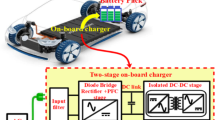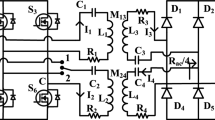Abstract
In this paper, a hybrid-bridge LLC series resonant converter with low circulating current and reduced switching losses for on-board battery charging of plug-in electric vehicle (PEV) is presented. Full-bridge (FB) is utilized in LLC converter with narrow range switching frequency within below resonance frequency region for depleted battery charging. To cover the charging voltage range for deeply depleted battery, the converter operates using half-bridge (HB) in both above and below resonance frequency regions. For both modes, the converter uses two fixed voltage levels at input to keep the switching frequency in narrow range. MATAB Simulink is used to simulate the converter with 3 kW maximum output power. Simulation results show that the LLC converter covers the wide charging voltage range 100–420 V for deeply depleted to fully charged battery using the constant-current, constant-voltage (CC-CV) charging, having lower turn-off current of power switches and low circulating current in resonant tank.
Access provided by CONRICYT-eBooks. Download conference paper PDF
Similar content being viewed by others
Keywords
1 Introduction
Due to global warming issues and the threat of fossil fuel depletion, the interest is growing in hybrid electric vehicles (PEVs) [1]. These vehicles are usually equipped with lithium-ion (Li-ion) battery packs having many attractive features like high energy density, slow charge loss, and no memory effect [2]. Figure 1 shows a commonly used power architecture of an on-board PEV battery charger [1] with power factor correction (PFC) and DC/DC conversion stages. Due to its simple structure and good performance for THD reduction, boost converter is commonly used as PFC converter [2].
At DC/DC stage, among different available solutions, LLC resonant converter has become an attractive topology due its desirable features including high efficiency, high power density, wide operation range, and high frequency operation [1]. These features fit the demands of an on-board PEV charger. A topological analyses in [3] shows that among other resonant topologies, the LLC converter out performs for PEV battery charging. This paper is focusing the DC/DC stage of the battery charger in Fig. 1.
A typical charging profile of a single cell lithium-ion battery is shown in Fig. 2 [2]. From this profile, the voltage range of a PEV battery pack can be extracted which maps to the wide range of 100–420 V. The deeply depleted battery have voltage range as 100 V ≤ V bat < 250 V whereas the depleted battery have voltage range 250 V ≤ V bat ≤ 420 V. Consequently, the battery charger must be compatible with this wide range [2].
Various battery charging solutions with fixed [1, 4] as well as variable DC-link voltage [2, 5] have been proposed. Both [1] and [4] use LLC converter for depleted battery charging voltage range without considering deeply depleted battery. Also in [5] depleted battery is considered, following the battery voltage at DC-link for operating LLC converter around resonance frequency. This approach reduces the switching and conduction losses of LLC but deeply depleted battery is not considered. In [2] deeply depleted battery charging is considered using SEPIC converter at PFC stage but the turn-off current of the switches is in the range of 1.2–5.1 A, which is still high.
In this paper, hybrid-bridge LLC converter is considered for deeply depleted PEV battery charging as well having low turn-off current range 1.02–4.023 A. For depleted battery charging, LLC operates with full-bridge. For charging of occasionally deeply depleted battery, full-bride operates as half-bridge using only two power switches. The rest of paper is organized as in Sect. 2, LLC resonant converter is described and its DC gain equation is given with resonant tank parameters calculation steps. In Sect. 3, simulation results are presented and Sect. 4 gives some conclusion.
2 LLC Resonant DC-DC Converter
LLC resonant converter has gained a lot of attention for having simple structure and desirable features like reduced switching losses, zero voltage switching (ZVS), zero current switching (ZCS) [1–5]. LLC series resonant converter with hybrid-bridge is shown in Fig. 3. For usual case of depleted battery charging, LLC resonant converter operates using full-bride (FB). Half-bridge (HB) mode will only be used for charging occasionally deeply depleted battery by operating switches S 1 and S 2 and keeping S 3 OFF and S 4 ON. Thus the transition from HB to FB will only occur during charging when battery voltage reaches 250 V. Figure 4 shows the mode transition circuit with S as selector. When battery voltage is less than 250 V, S becomes 0 and HB is selected with Vgs3 = 0 and Vgs4 = 1, where Vgs represents the gate pulse of switch. For depleted battery, S = 1 and FB is selected with Vgs3 = Vgs2 and Vgs4 = Vgs1. To avoid any possible damage to switches the bridge transition will occur only during dead time of switching pulses.
For LLC converter there are two resonant frequencies which are given by:
To fulfill the gain requirements for wide charging voltage range, LLC converter with fixed input voltage have to operate with wide switching frequency (f sw ) range. But the LLC converter have maximum efficiency operation around the resonance frequency f r1 with minimum circulating current in resonant tank [2]. In above f r1 region, secondary rectifier diodes do not have ZCS operation and, in below f r1 region, the power switches have non-zero turn-off current causing switching losses. Circulating current increases as f sw moves away from f r1, particularly in below f r1 region, and it does not contribute to the power transfer but generates the conduction losses [2]. To minimize the circulating current, the magnetizing inductance must be chosen maximum possible which satisfies the gain requirements and f sw must have narrow range.
To keep f sw in narrow range, the converter is designed to operate with two levels of DC-link voltage (V dc ) for both FB and HB operating modes. The V dc values and their corresponding charging voltage ranges are given in Table 1. The DC gain of the LLC converter using first-harmonic approximation (FHA) approach, is given as [1]:
where \(k = \frac{{L_{m} }}{{L_{r} }}, \, f_{n} = \frac{{f_{sw} }}{{f_{r1} }},\,Q = \frac{{Z_{0} }}{{R_{ac} }} = \frac{{\sqrt {L_{r} /C_{r} } }}{{R_{ac} }},\,R_{ac} = n^{2} \frac{8}{{\pi^{2} }}\frac{{V_{bat}^{2} }}{{P_{0} }}\) with P 0 as output power.
Using (3) the DC characteristics of LLC converter can be derived. The resonant tank parameters of LLC converter with full-bridge configuration using FHA can be calculated using following steps:
-
Step 1.
Step 1. Calculate the transformer’s turns ratio (n), minimum and maximum gain values using the following equations with V 0 as output voltage and V i as input:
$$n = \frac{{V_{i} }}{{\left( {V_{0} + V_{f} } \right)}},\,G_{min} = \frac{{n\left( {V_{0min} + V_{f} } \right)}}{{V_{imax} }},\,G_{max} = \frac{{n\left( {V_{0max} + V_{f} } \right)}}{{V_{imin} }}.$$where for diodes V f = 0.8 V.
-
Step 2.
Select the suitable values of inductance ratio k and quality factor Q from the gain versus normalized frequency f n plot of (3) satisfying G min and G max .
-
Step 3.
Choose the resonance frequency f r1 and calculate R ac to calculate \(Z_{0} = QR_{ac}\). Using values of f r1, \(Z_{0}\) and k calculate:
$$C_{r} = \frac{1}{{2\pi f_{r1} Z_{0} }},\,L_{r} = Z_{0}^{2} C_{r} \,\text{and}\, L_{m} = kL_{r} .$$
Using above procedure with f r1 = 200 kHz, n = 1.5949, Q = 0.4, and k = 4, the converter is designed in ZVS region below resonance frequency to have maximum efficiency. The tank parameters are calculated as: C r = 10.072 nF, L r = 62.87 µH, and L m = 251.48 µH.
3 Simulation Results
LLC resonant converter for DC/DC stage of PEV battery charger has been simulated using MATLAB Simulink and results for both depleted and deeply depleted battery charging, considering battery as resistive load [5], are shows in Figs. 5, 6 and 7. The DC-link voltage is assumed to be regulated by PFC converter at required value using state of charge of battery. When V dc level changes during charging, f sw becomes equal to f r1. The waveforms of tank input voltage V ab , magnetizing current I Lm , resonant inductor current I Lr , resonant capacitor voltage V cr , and the charging current I bat are shown in the results.
3.1 Deeply Depleted Battery Charging
For deeply depleted battery charging, LLC converter uses HB with two V dc levels given in Table 1, for charging in CC mode with I bat = 1.02 A, operating in both below and above f r1 regions. Figure 5 shows the waveforms at two key operating points A and B in Fig. 1. In Fig. 5a the converter is operating at f sw = 276.417 kHz with V bat = 100 V and turn-off current as 1.293 A resulting low switching losses. Figure 5b shows the operation at V bat = 250 V using HB at f sw = 136.87 kHz and turn-off current 2.495 A.
3.2 Depleted Battery Charging
Figure 6 shows the operation of LLC using FB for depleted battery charging using CC charging mode with I bat = 7.15 A at two V dc levels given in Table 1. Figure 6a shows the operation at V bat = 250 V with V dc = 400 V and f sw = 200.15 kHz. Figure 6b shows the operation at V bat = 420 V with V dc = 520 V and f sw = 146.432 kHz when charging mode transition occurs from CC to CV. Figure 7 shows the operation of the converter in CV mode when the current falls down to 0.51 A and charging process is terminated.
4 Conclusion
In this paper LLC converter with hybrid-bridge has been presented for PEV battery charging taking into account the deeply depleted battery charging also. The converter used FB for depleted battery charging and HB for deeply depleted battery charging with low turn-off current of switches which reduced switching losses and circulating current. Simulation results showed that the converter covers the wide charging voltage range of 100–420 V for CC-CV charging of PEV battery pack.
References
Deng J, Li S, Hu S, Mi CC, Ma R (2014) Design methodology of LLC resonant converters for electric vehicle battery chargers. IEEE Trans Veh Technol 63(4):1581–1592
Wang H, Dusmez S, Khaligh A (2014) A novel approach to design EV battery chargers using SEPIC PFC stage and optimal operating point tracking technique for LLC converter. In: 2014 Twenty-ninth annual IEEE applied power electronics conference and exposition (APEC), pp 1683–1689, 16–20 Mar 2014
Wang H, Khaligh A (2013) Comprehensive topological analyses of isolated resonant converters in PEV battery charging applications. In: Transportation electrification conference and expo (ITEC), 2013 IEEE, pp 1–7, 16–19 June 2013
Wang H, Dusmez S, Khaligh A (2014) Design and analysis of a full-bridge LLC-based PEV charger optimized for wide battery voltage range. IEEE Trans Veh Technol 63(4):1603–1613
Wang H, Dusmez S, Khaligh A (2014) Maximum efficiency point tracking technique for LLC based PEV chargers through variable DC link control. IEEE Trans Ind Electron 61(11):6041–6049
Acknowledgments
The authors would like to thank Universiti Sains Malaysia (USM) for providing all necessary facilities and equipment to make this research possible. This work was supported by Research University Grant (RUI) 1001/PELECT/814207 from USM.
Author information
Authors and Affiliations
Corresponding author
Editor information
Editors and Affiliations
Rights and permissions
Copyright information
© 2017 Springer Science+Business Media Singapore
About this paper
Cite this paper
Shahzad, M.I., Iqbal, S., Taib, S. (2017). Hybrid-Bridge LLC Series Resonant Converter for Deeply Depleted PEV Battery Charging. In: Ibrahim, H., Iqbal, S., Teoh, S., Mustaffa, M. (eds) 9th International Conference on Robotic, Vision, Signal Processing and Power Applications. Lecture Notes in Electrical Engineering, vol 398. Springer, Singapore. https://doi.org/10.1007/978-981-10-1721-6_92
Download citation
DOI: https://doi.org/10.1007/978-981-10-1721-6_92
Published:
Publisher Name: Springer, Singapore
Print ISBN: 978-981-10-1719-3
Online ISBN: 978-981-10-1721-6
eBook Packages: EngineeringEngineering (R0)











